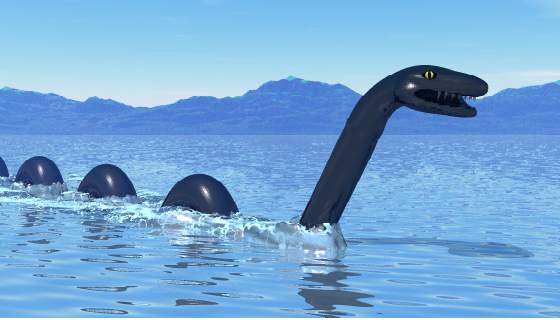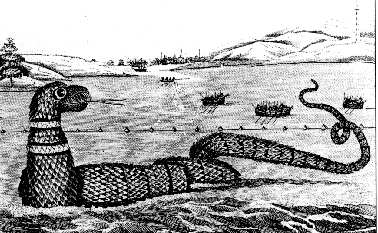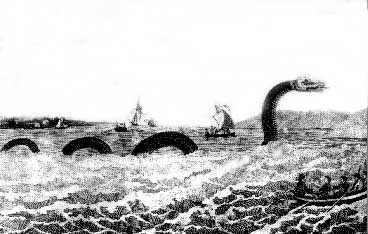pop up description layer
HOME
Cryptozoology UFO Mysteries Aviation Space & Time Dinosaurs Geology Archaeology Exploration 7 Wonders Surprising Science Troubled History Library Laboratory Attic Theater Store Index/Site Map Cyclorama
Search the Site: |
|
The Monstrous Sea Serpent of Gloucester
They told me of a sea serpent, or snake, that lay quoiled up like a cable upon the rock at Cape Ann; a boat passing by with English on board, and two Indians, they would have shot the serpent, but the Indians dissuaded them, saying that if he were not killed outright, they would all be in danger of their lives... The report by John Josselyn in 1638 is one of the earliest sightings of an animal that would haunt the coast of New England, and especially the port of Gloucester, for more than three centuries and be seen by hundreds of people. The report is of a creature that science says does not exist: A sea serpent. The harbor of Gloucester, Massachusetts is located just north of Boston on the lower part of Cape Ann which juts out into the Atlantic Ocean. Gloucester has always been a seafaring town. Its harbor is well protected from Atlantic storms, making it a destination for ships hauling cargo. In the 17th century fish abounded off the coast ready to caught by enterprising and brave men willing to go to the sea in boats. If any group of people should have known the sea and local inhabitants, it should have been the fishermen and sailors of Gloucester. Obadiah Turner reported the following incident with a similar creature off Lynn, Massachusetts three years later. Some being on ye great beache gathering of calms and seaweed wch had been cast thereon by ye mightie storm did spy a most wonderful serpent a shorte way off from ye shore. He was big round in ye thickest part as a wine pipe; and they do affirm that he was fifteen fathoms [90 feet] or more in length. A most wonderful tale. But ye witnesses be credible, and it would be of no account to them to tell an untrue tale. Wee have likewise heard yt Cape Ann ye people have seene a monster like unto this, whch did there come out of ye land mch to ye terror of them yt did see him. A Seasonal Serpent Although sea serpent incidents occurred occasionally off the coast of Cape Ann and the rest of New England during the 17th and 18th centuries, it wasn't until the 19th century that the arrival of the sea serpent off the coast became a nearly seasonal phenomenon. The real action started in August of 1817 when two women claimed they had seen the creature swimming into the harbor. The same sea-serpent was seen at almost the same time by the Captain of a coasting vessel. A few days later Mrs. Amous Story said she saw what appeared to be a tree trunk washed up on the rocks of Ten Pound Island which lies in the harbor. As she watched it through a telescope, it moved and when she looked again, it was gone. William Row reported seeing a creature saying "its head was as broad as a horse or more so, but not quite as long." The same day Amos Story also saw the creature: It was between the hours of twelve and one o'clock when I first saw him, and he continued in sight for an hour and a half. I was setting on the shore, and was about twenty rods from him when he was the nearest to me. His head appeared shaped mach like that of the sea turtle, and he carried his head from ten to twelve inches above the surface of the water. His head at that distance appeared larger than the head of any dog I ever saw. From the back of his head to the next part of him that was visible, I should judge to be three or four feet. He moved very rapidly through the water, I should say a mile or two or, at most, in three minutes. I saw no bunches on his back. On this day, I did not see more than ten or twelve feet of his body. Two days later on August 12th Shipmaster Solomon Allen III saw the Gloucester sea serpent: His head formed something like the head of a rattlesnake, but nearly as large as the head of horse. When he moved on the surface of the water his motion was slow, at times playing in circles, and sometimes moving straight forward. The creature was even shot at two days later by ship's carpenter Matthew Gaffney from a boat: I had a good gun, and took good aim. I aimed at his head, and I think I must of hit him. He turned toward us immediately after I had fired, and I thought he was coming at us; but he sunk down and went directly under our boat, and made his appearance at about one hundred yards from where he sunk... Gaffney also mentions the motion of the creature through the water was "vertical, like a caterpillar."
There were eighteen sightings of the "sea serpent" that year. Most from Gloucester, but a few from different parts of New England. Most of the reports were very similar: A snakelike creature, sixty to one-hundred feet in length, with the head the size of a horse and the body the diameter of a barrel. Observers noted that the creature swam with a vertical motion and his body appeared as "humps" behind him. This report from Cheever Felch aboard the United States schooner Science: His colour is dark brown with white under his throat. His size we could not accurately ascertain, but his head is about three feet in circumference, flat and much smaller than his body. We did not see his tail; but from the end of the head to the farthest protuberance was not far from one hundred feet. I speak with a degree of certainty, behing much accustomed to measure and estimate distances and length. I counted fourteen bunches on his back, the first one say ten or twelve feet from this head, and the others about seven feet apart. They decreased in size towards the tail. These bunches were sometimes counted with and sometimes without a glass. Mr. Malborne counted thirteen, Mr. Blake thirteen and fourteen, and the boatman the same number...His motion was partly vertical and partly horizontal, like that of fresh water snakes. I have been much acquainted with snakes in our interior waters. His motion was the same. Reports off the New England coast continued strong through the 19th century. Twelve sightings in 1839, nine in 1875 and thirteen in 1886. A total of 190 for the whole one hundred years. Sea serpent reports became fewer in the twentieth century: A total of 56, and most of those before 1950. A Case of Misidentification? So what was the Monstrous Sea Serpent of Gloucester? Most such reports are attributed to simple misidentification. Dolphins leaping in single file might look like a series of humps. The sixteen-foot-long elephant seal might look like a sea monster to someone unfamiliar with the giant seal. In many of the Gloucester reports, though, observers first felt they were viewing something quite normal, but then changed their minds when they got closer (Opposite to what you would expect in a case of misidentification). For example, this report by John Brown, published in 1817: ...I discovered something about three or four miles distant, about two points on the weather bow, which appeared as a mast, as it rose and sunk in a perpendicular manner, once in about eight or ten minutes. I kept the vessel directly for it, and after look at it with my glass, I observed to my mate that i was a wreck, as I could see timbers &c.. sticking up, but as we approached nearer, I found what appeared like timbers to be a number of porpoises and black fish playing and jumping around a large Sea-Serpent, which we had supposed to be the mast. Some sea serpent reports are hoaxes either perpetrated by individuals, or in many cases by newspapers. Hoax journalism is an art which was alive in the 19th century, but has almost disappeared today. While many of the reports have been found through period newspapers, others show up in private letters, which indicates they were not part of a hoax journalism story. Even in the case of the newspaper stories, many of the references to the Gloucester sea serpent seem to lack the kind of sensationalism that was often a part of hoaxed articles. So how do we explain the many sightings at Gloucester and along much of the coast of New England? Was there really a sea serpent swimming along the shores? The idea that there might be such a thing as a sea serpent is not as preposterous as it sounds at first. We certainly know that millions of years ago, at the time the dinosaurs ruled the land, giant marine reptiles, some 80 feet in length, ruled the seas. Some people have suggested that some version of these creatures managed to survive the great extinction at the end of the Cretaceous Era that killed dinosaurs. They think that the snakelike body reported might be the long neck of a Elasmosaurus or the back of a Mosasaur. The Gloucester sea serpent might not necessarily be Cretaceous leftover, though. Plenty of sea-snakes are alive today living in tropical waters. While these are much smaller than any sea-serpent reported in New England, one water snake does nearly reach the sizes mentioned: The Anaconda. Anacondas live in South American waters and have been reported at up to 37 feet in length with the girth of a telephone pole. They mostly live in fresh water and rarely venture into the open sea. However, is it so incredible to believe that there might be a cousin of the Anaconda which is twice the length and diameter and lives in the open sea?
If the Gloucester reports are genuine and accurate, why are there so few in twentieth century and almost none in the past few years? J.P. O'Neill, author of The Great New England Sea Serpent, theorizes that the deterioration of the once-fertile fishing areas off of New England by over-fishing may have caused the creature to find another place to eat, or even go extinct. Ironically that would mean that a hundred years ago there was once a population of sea-serpents, but now they are gone. The last sighting in New England was off the coast of Marshfield, Massachusetts in 1962. There were no reports in the 1970's or 1980's at all. With careful protection of the fisheries, though, hopefully the population of fish may rebound. Will it be in time to help the Gloucester sea serpent, assuming of course that this creature ever really existed at all? Perhaps there is some hope. In 1997, after over thirty years of silence, a report came from Fortune Bay, Newfoundland. It turned its head and looked right at us. All we could see was a neck six feet long, a head like a horse, but his dark eyes were on the front of his face... Perhaps the sea serpent is not dead, but just waiting to return to his summer feeding grounds near Gloucester harbor.
Copyright Lee Krystek 2000. All Rights Reserved |
|
Related Links |
|
|






